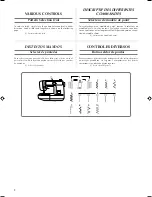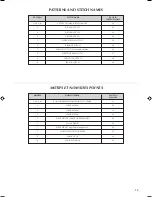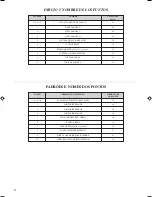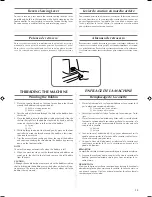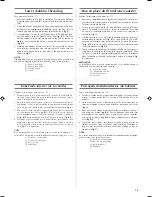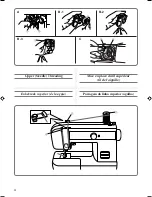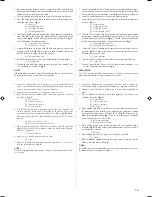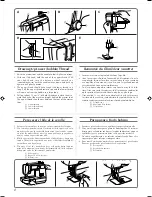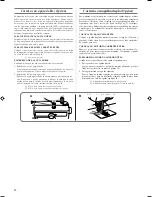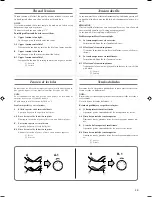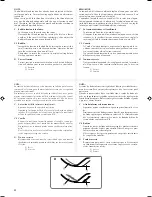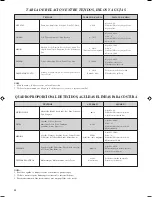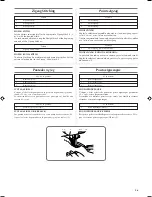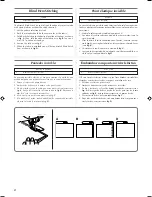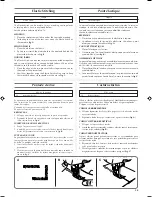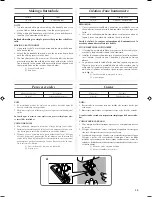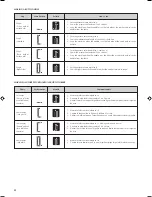
○○○○○○○○○○○○○○○○○○○○○○○○○○○○○○○○○○○○○○○○○○○○○○○○○○○○○○○○○○○○○○○○○○○○○○○○○○○○○○○○○○○○○○○○○○○○○○○○
16
1. Raise the presser foot using the presser foot lifter and turn the
balance wheel toward you (counterclockwise) to raise the thread
take-up lever to its highest position.
2. Pull up the spool pin and place a spool of thread on this pin.
3. Pass the thread through both thread guides: the rear one first,
then the front one. (
fig. A
)
1
Spool pin
2
Thread guide (rear)
3
Thread guide (front)
4
Thread take-up lever
4. Pull the thread down and around the upper tension control dial
from the right to the left so the thread picks up the thread check
spring. (See
fig. B
.) While holding the thread as shown in
fig. C
,
pull it between the tension discs.
5
Upper tension control dial
6
Thread check spring
5. Guide the thread to the back of the thread take-up lever and
around to the left (
fig. D
). Bring the thread through the slit by
pulling it toward you and into the eyelet.
7
Thread take-up lever
6. Bring the thread down and pass it behind the thread guide.
8
Thread guide
7. Thread the needle from front to back and pull out about 5 cm
(2") of thread as shown in
fig. E
.
NOTE:
If the thread is incorrectly fed, the thread may break, cause stitches
to be skipped or cause the fabric to wrinkle.
1. Lever le pied-de-biche à l’aide du levier correspondant et tour-
ner le volant à main vers soi (dans le sens contraire aux aiguilles
d’une montre) pour remonter complètement le levier releveur.
2. Lever le porte-bobine et y placer une bobine de fil.
3. Faire passer le fil par les deux guide-fils: d’abord l’arrière puis
l’avant. (
fig. A
)
1
Porte-bobine
2
Guide-fils (arrière)
3
Guide-fils (avant)
4
Levier releveur de fil
4. Tirer le fil vers le bas et le faire passer par le disque de contrôle
de tension supérieure de droite à gauche afin que le fil attrape
le ressort de vérification (voir
fig. B
). Tirer le fil entre les disques
de tension, tout en le tenant comme le montre la
fig. C
.
5
Disque de tension du fil
6
Ressort de vérification du fil
5. Guider le fil vers l’arrière du levier releveur puis autour vers la
gauche (
fig. D
). Amener le fil vers la fente en le tirant vers soi et
le faire passer par le chas.
7
Levier releveur
6. Tirer le fil vers le bas et le faire passer derrière le guide-fils.
8
Guide-fils
7. Enfiler l’aiguille de l’avant vers l’arrière et tirer environ 5 cm
(2") de fil comme le montre la
fig. E
.
REMARQUE:
Si le fil n’est pas installé correctement, il peut se rompre, causer
des sauts de points ou des fronces dans le tissu.
1. Levante el prensatelas con la palanca y gire la ruedecilla hacia
usted (en el sentido contrario al de las manecillas de un reloj) para
subir la palanca tirahilos a su posición más alta.
2. Levante el porta carretes y coloque un carrete en el eje.
3. Pase el hilo a través de ambas guías: la de atrás primero y luego la
de delante. (
fig. A
)
1
Porta carretes
2
Guía hilo (trasera)
3
Guía hilo (delantera)
4
Palanca tirahilos
4. Tire del hilo hacia abajo, pasando por el disco de control de la
tensión superior de derecha a izquierda de tal forma que el hilo
enganche el resorte de comprobación del hilo. (Véase
fig. B
). Mien-
tras sujeta el hilo tal como indica la
fig. C
, páselo por los discos de
tensión.
5
Disco de tensión del hilo
6
Resorte de comprobación del hilo.
5. Guíe el hilo por detrás de la palanca tirahilos y por la izquierda
(
fig. D
). Lleve el hilo por la ranura, tirándolo hacia usted y pasán-
dolo por el agujero.
7
Palanca tirahilos
6. Baje el hilo y páselo por detrás de la guía.
8
Guía
7. Enhebre la aguja de delante hacia atrás y saque unos 5 cm (2") de
hilo tal como indica la
fig. E
.
NOTA:
Si el hilo está mal enhebrado, puede romperse, saltar puntadas o frun-
cir el tejido.
1. Levante o calcador com a alavanca e gire com a mão o volante, na
sua direção (para a esquerda) para lerantar ao máximo o estica-fio.
2. Levante o porta-carretel e coloque no seu eixo um carretel de li-
nhas.
3. Passe a linha através dos dois guia-fios: primeiro o posterior, e em
seguida o anterior. (
fig. A.
)
1
Porta-carretel
2
Guia-fio (posterior)
3
Guia-fio (anterior)
4
Estica-fio
4. Puxe a linha para baixo e contorne o botão de regulagem da tensão
da linha superior, da direita para a esquerda, de forma que a linha
passe pela mola de tensáo da linha. (Veja a
fig. B.
) Segurando na
linha da forma indicada na
fig. C
, puxe-a com força para encaixala
entre os discos tensores (do botão).
5
Botão tensor da linha
6
Mola de tensáo da linha
5. Guie a linha para a parte de trás do estica-fio e em seguida para a
esquerda (
fig. D
); Passe-a através da fenda puxando-a para si e enfie-a
no orifício do estica-fio.
7
Estica-fio
6. Puxe a linha para baixo e passe-a por detrás do guia-fio.
8
Guia-fio
7. Enfie a linha na agulha da frente para trás e puxe cerca de 5 cm de
linha, conforme mostra a
fig. E
.
NOTA:
Se a linha não estiver corretamente passada, poderá partir-se provocan-
do falha de pontos ou franzir o tecido.
○ ○ ○ ○ ○ ○ ○ ○ ○ ○ ○ ○ ○ ○ ○ ○ ○ ○ ○ ○ ○ ○ ○ ○ ○ ○ ○ ○ ○ ○ ○ ○ ○ ○ ○ ○ ○ ○ ○ ○ ○ ○ ○ ○ ○ ○ ○ ○ ○ ○ ○ ○ ○ ○ ○ ○ ○ ○ ○ ○ ○ ○ ○ ○ ○ ○
LS2125_EFSpPo_1-23.p65
03.11.13, 3:16 PM
16
Summary of Contents for LS 2125 - Sewing Machine 25 Stitch Function
Page 1: ...on Manual d instructions de instrucciones de Instruções ...
Page 67: ......








